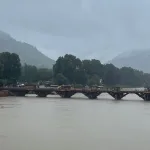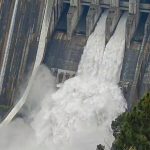Calamities, catastrophes, disasters and nasty weather vagaries devastate and ravage cherished human establishments in a jiffy. Callously calamitous wrath of nature wrecks havoc on prosperously inhabited human settlements, and razes them to rubble. Pages of history corroborate the fact that many civilizations have been crumbled and pulverized by episodes of natural blitzkrieg. High magnitude earthquakes, violent storms, torrential deluges and intensely ferocious Tsunamis have been detrimental in the agony of human beings. Of late, the world witnessed some awful events of natural onslaught. Turkey was shattered during 2023 by cruel jolts when the earth shook vehemently to bury people under massive skyscrapers. Who can forget the years 2001 and 2004 when the Indian Ocean simmered fiercely to demolish its vastly mammoth coastal areas. There are hundreds of instances when the monster of nature tried to devour humans.
Our famed valley is no exception to it. The earthly paradise has undergone many floods, famines and earthquakes, which consequently reduced the population of the vale drastically. Known for its breathtakingly picturesque beauty and elegant aesthetics, the valley of velvety meadows has suffered brutal dents at the hands of nature. Historians have recorded the dastardly episodes of natural outrage, and the jaw-dropping incidents give readers goose bumps. Though Kashmir valley is prone to floods, and our ancestors have witnessed some terrible inundations, yet, loss of life has been relatively less. But, quakes and famines have been viciously lethal to reduce the population of the valley by manifolds. Earthquakes of 1864 and 1885 and their aftershocks gave sleepless nights to kashmiris for months together. Though the population of the valley was very thin then, but, still, the shocks took heavy toll of life. During the earthquake of 1885, Baramulla and Pattan areas were badly affected. Rifts and fissures in land were reported in these two towns, and the emission of sulphur fumes coupled with inflammable gases were also found here.
Famines in our valley are believed to be the harshest manifestation of natural calamities. Native historians and chroniclers of the valley have recorded some 19 terrible famines. The gruesome details about these famines send shivers down the spine of readers. Most of the famines were either caused by untimely snowfalls or relentless rains. Walter Lawrence in his famous travelogue – “The valley of Kashmir “makes mention of two dreaded famines of 19th century AD. Famine of Sher Singh is believed to be appallingly awful, because the famine had come like a holocaust on the natives of Kashmir. According to calculations and estimations, the cruel famine called Sher Singh reduced the population of Kashmir valley from 8, 00,000 (Eight Lakh) to mere 2, 00,000 (Two Lakh). The famine was caused by the ill-timed snow of 1831. According to reliable historic sources, the unreasonable snow perished harvested and standing crops completely, which left granaries and stores empty.
Another terrible famine, kashmiris have combated during 19th century AD, belongs to the year 1877-78 when unceasingly rains submerged paddy and other farms fully. Rains started in October 1877, and gates of the skies continued to shower vollies of water on the lands of the valley for almost four months. People failed to bring home their harvested and standing crops. The rains proved a bolt from the blue for the residents of the valley. Historians state that the population of Srinagar city dwindled badly from 1, 27,400 to mere 60,000. Hunger killed people ruthlessly. The famines left indelible scars on the spines of our ancestors.
A famous Kashmiri adage narrating the pangs of the famines became famous probably after these famines. Draagh Tchali, Daagh Tchali Na (Famines will go, but scars won’t). The grievous famines forced our forefathers to eat unripe mulberries and other wildly grown fruits. Bark of elm trees and yew were ground into flour. Many would eat grasses and roots of swamps and forest trees. The famine turned uglier during 1878. Wells and pits were choked with dead bodies. Non-burial of thousands of corpses created fear-psychosis and terror among Kashmiris. Even prowling dogs are said have preyed on human carcasses. The horrors of 1878 famine moisten our eyes even after hundreds of years. The plight of our forefathers went unabated during 1879 as well, though bumper fruit harvest proved a panacea for the peril of starvation, but the cholera of 1879 summer had worsened the situation. Ah! Our poor progenitors and ancestors.
Miseries and pains are stored in our palm lines. Apart from nature’s fury and rage, Kashmir valley has undergone political strife and strain for centuries together. Many cruel kings have drunk our blood like vampires and cannibals. I mean, Kashmiris have witnessed tough times, but, our resolve, determination and indomitable attitude to resist boldly, has helped us to conquer adversities and predicaments. We have withstood many turbulent times and vicious cycles of violence and indignation. Year 2024 is somewhat full of climatic chaos. We haven’t had sufficient sunshine during the first five months of the year. Even we have already escaped a major deluge, a couple of weeks ago when Vitasta and its tributaries had swollen angrily. Inordinate human activities surely aggravate the plight of the planet, and nature revenges equally. We need to be more careful and environmentally conscious to live in harmony with nature.
(Author is a Teacher and a Columnist. He can be reached at [email protected])







